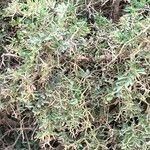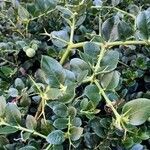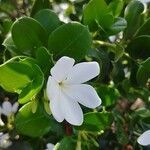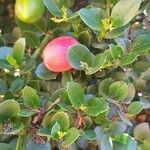Shrub up to 4 m high, twiggy, densely branched, evergreen, spiny; branches divaricate, glabrous; sap milky; spines once or twice bifurcate, 2-4.5 cm long, arising usually in pairs at the apex of a shoot and decussate to the apical pair of leaves, often bearing an inflorescence in the angle of the fork, persistent, rigid, becoming woody. Leaves coriaceous, broadly ovate to ovate-elliptic or subrotund 2.5-6 cm long and 1.7-3.5 cm broad, truncate to obtuse at the base, apex obtuse to acute, mucronate, glabrous, glossy dark green above, paler below; secondary nerves 5-7 on each side, obscure; petiole short, up to 5 mm long, channelled above; axillary glands conspicuous; stipules 0. Inflorescence cymose, contracted, few-flowered, sometimes reduced to 1, subsessile at the ends of the branchlets or sometimes in the fork of a spine, glabrous; bracts ovate to lanceolate, acuminate 3-4 mm long, deciduous; pedicels up to 3 mm long. Flowers large, variable in size, heterogamous, white, scented. Calyx 4-7 mm long, glabrous; sepals 5, ovate-lanceolate to lanceolate, acuminate. Corolla salver-shaped; tube cylindric, 9-14 mm long, glabrous without, hairy within; lobes 5, oblong to elliptic, 1.5-3.5 cm long and 4-6 mm broad, narrowed towards the base, apex rounded, overlapping to the left, glabrous. Stamens 5, inserted at the middle of the tube, anthers subsessile, of two lengths in different plants, 1.5 mm (and apparently sterile) or 2-5 mm long. Disc 0. Ovary entire, 2-chambered, each with many ovules; style of two lengths in different plants, the longer about 6 mm long(in flowers with short, sterile anthers), the shorter 3-4 mm long, thus the stigma either level with or distinctly below the anthers; stigma ellipsoid. Fruit a berry, ovoid, pointed, up to 5 cm long and 3.5 cm in diameter, red, with milky latex, edible. Seeds 16 or more, peltate, flat, irregularly elliptical in outline; testa papillose, hard; embryo straight; cotyledons broadly elliptical, slightly longer than the radicle; endosperm plentiful, horny.
A small evergreen shrub. It grows up to 5 m tall. It branches densely and has many forked spines. They are usually in pairs at the top of shoots. The branches are smooth and light brown. branches exude milky latex when cut. The leaves are produced opposite one another. They are simple leaves with short stalks. The leaves are oval and shiny. The top surface is dark green and the lower surface is paler green. The leaf has a thorn like tip. The flowers are in clusters at the ends of twigs. The flowers are 5 cm across and white. They have a sweet smell. The flowers a like tubes and the petals spread out. The fruit are oval red berries. They are 2.5-5 cm long. They are produced on the tips of young shoots. Seeds are flat and papery. The number of seeds varies. The fruit are edible.
Small to large shrub or tree-like, 1-4(-5) m high. Stems with stout spines, once or twice bifurcate, 20-45 mm long. Leaves broadly ovate, ovate-elliptic to subrotund, (20-)25-60 x 17-35 mm; petioles up to 5 mm long. Inflorescences at axil of spines or terminal. Flowers salver-shaped, white, heteromorphic. Calyx 4-7 mm long. Corolla: tube 9-14 mm long, hairy inside; lobes 15-35 mm long. Anthers of two lengths: 15 mm in sterile flowers and 25 mm in others. Style heterostylous: 6 mm in flowers with short sterile anthers, and 3-4 mm long in others; stigma entire. Flowering all year. Fruit an ovoid berry, 30-50 x 30-35 mm. Seeds 16 or more.
Shrubs or small trees to 5 m tall. Spines 1-or 2-forked, 2-4 cm, strong. Leaf blade broadly ovate, 2.5-7.5 X 2-5 cm, thick leathery, glabrous, base rounded to obtuse, apex mucronate, lateral veins obscure. Cymes terminal, (1-)3-flowered. Pedicel 2-3 mm. Flowers fragrant. Sepals very narrowly ovate, 3-6 mm. Corolla white or pink, tube 1.1-1.8 cm, pubescent inside; lobes oblong, 0.9-2.4 cm, overlapping to left. Ovules numerous. Berries bright red to violet, ovoid, 2-5 cm, ca. 16-seeded. Fl. Aug. 2n = 66.
Lamina 2·4–7 x 1·7–5·2 cm., broadly to narrowly ovate or subcircular, the apex obtuse, mucronate, the base rounded; upper surface with midrib impressed and lateral nerves faintly raised, usually indistinct; lower surface with midrib prominent and lateral nerves level or ± impressed, very indistinct; margin revolute, not crenate.
Gynoecium glabrous; ovary fusiform and 2–3·5 mm. long in long-styled flowers or conical and up to 1 mm. long in short-styled flowers; style and stigma 6–7 mm. long, the stigma reaching beyond the anthers, or only 2·5–3 mm.; stigma pubescent at apex, not obviously bifid.
Calyx 2–4·5(7) mm. long; segments narrowly triangular to broader and somewhat foliaceous, glabrous, not ciliate; fleshy triangular dark-coloured scales c. 0·5 mm. long present, variable in number, shortly attached to base of sepals on their margins and inner surface.
Stamens inserted at the middle of the corolla tube; anthers subsessile, 1·25–2 mm. long (1·25 mm. and apparently non-functioning in long-styled flowers, 1·75–2 mm. in short-styled flowers).
Leaves thickly coriaceous, glabrous, often drying discolorous with dark grey to brown upper surface and pale green to brown lower surface; petiole 2–4 mm., glabrous.
Young stems glabrous, greenish, strongly wrinkled into longitudinal ridges and channels; older twigs similar, with greenish or brownish, often glossy, surface.
Flowers pentamerous, in sessile or shortly pedunculate terminal 1–few-flowered cymes, white, jasmine-scented, heterostylous.
Corolla tube 11–18·5 mm. long, glabrous or pubescent on outer surface, sparsely to densely pilose within on the upper 2/3.
Corolla lobes 9–24 mm. long, broadly elliptic, glabrous or pubescent on upper and lower surfaces, overlapping to the left.
Spines usually bifurcate, the axis (2)5–22 mm., first branches (2)3–23 mm. and second branches (2)4–32 mm. long.
Like C. bispinosa but flowers larger, corolla lobes 15-35 mm and fruits 30-50 mm long.
Fruit 3–5 cm. long when fresh, ovoid, pointed, red and edible when ripe, many-seeded.
Many-stemmed shrub 1–3·7 m. high.
Seeds c. 6 x 4 mm.











